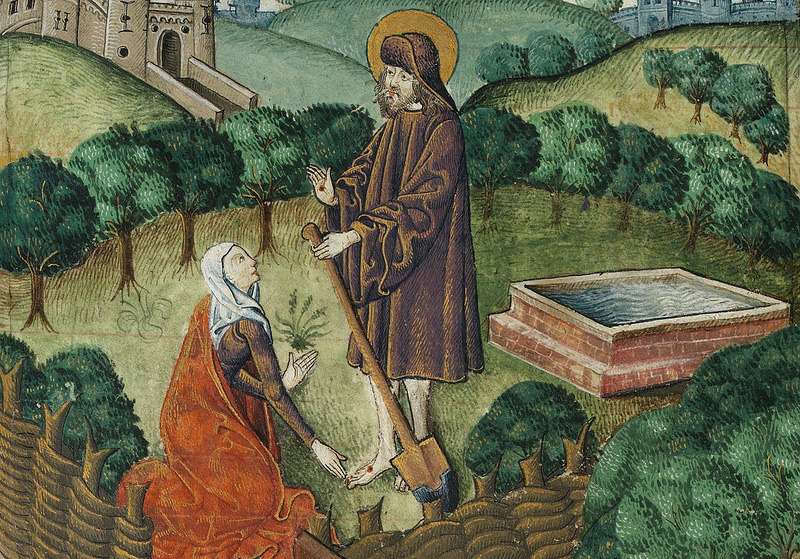Today’s gospel is that excitingly mysterious account of Mary Magdalene not recognizing Jesus. She thought he was the gardener.
I love that detail. In fact, he was the gardener. He was the second Adam, and St John sees the Garden of the Resurrection as the re-made Garden of Eden. Fallen Mary is restored Mary and so she echoes the greater Mary who is the second Eve.
But I’m fascinated by the interchange between Mary Magdalene and the Lord. She did not recognize him. Why not? I think there were three reasons.
First, she didn’t recognize him because she had only known the Jesus of Nazareth weighed down by the stress and sin of this life. She knew him weary and worn from sleepless nights in prayer. She knew him hungry and thin from desperate days of fasting. She knew him exhausted from preaching and worn down by the clutching crowds. She knew him last in his final agony, sweating blood, weeping and howling in terror and pain. She knew his broken body and remembered him as such.
She was not prepared to see a Jesus healed and glorified. I had an experience a bit like this. A girl came to my vicarage door when I was an Anglican priest. We’ll call her Sarah. She stumbled into the house and gasped, “I need to talk to a priest.”
I didn’t know her. Had never seen her before. She explained that she had a terrible pain within her abdomen. No pain killers could touch it. The doctors were mystified. She couldn’t sleep. She lost her job. It was constant, excruciating pain. She was doubled over and whimpering with this pain.
I suspected a deeper problem, so I asked her to describe the pain. I knew that often we use symbolic language to describe what is really wrong.
Sarah said, “It feels like my insides are being torn out.”
“Insides being torn out.” That sounds like an abortion to me.
So I gently began to ask if there was a relationship that had gone wrong. Then the whole sad story tumbled out. The affair with the married man. The unwanted pregnancy. His insistence that she have an abortion, her parents discovery. Her father kicking her out of the family home. Her father and boyfriend paying for the abortion (which she did not want). The violence, the pain and the misery were tangible. It was there in poor Sarah’s face, her body, her whole being.
I told Sarah there was healing to be had. I explained about the Eucharist and the presence of Jesus there. I said she could be forgiven. So we had a quiet Eucharist asking for healing and we laid hands on her and she was healed. The pain vanished almost instantly.
And here’s my point: The next week there was another knock on the door. It was Sarah. She was there with a friend. I didn’t recognize her. I really didn’t. She was standing up straight and tall. She was smiling. She was well and I had only known her in her pain. Once I realized who is it was I was aghast.
She and her friend came into the house. Sarah said, “This is my friend Tracy. I told her about what you did and how the pain went.”
“I’m pleased to meet you Tracy.”
Then Sarah said, “I think Tracy needs what you did for me too.”
Wow. That is how we recognize the resurrection. We recognize the resurrection because we don’t at first recognize the resurrection.
The second reason Mary Magdalene did not recognize the resurrection was because she had not mental and perception capabilities to do so. Students of the means of perception says we often do not see certain things because we do not have the mental equipment to see them. This is why some people, for example, see ghosts and others do not. Some people have the mental perception capabilities to see things that others cannot see because they do not have the means to process what they are seeing. They do not have the capability.
Mary Magdalene–like all of us–do not have the natural capacity to recognize the resurrection. It is all about us, but we cannot see it. We’re blind.
This is the secret of the spiritual life: to have resurrection eyes–to be able to see by the gift of grace–what others cannot see. It is the ability to see God’s work in the world not only in the things that please us, but also in the things that displease us and to trust him. It is the ability to see that in the midst of crisis, doubt, fear and distress God is still working his purpose out and that all things work together for good to those who love God and who are called according to his purpose.
The third reason Mary Magdalene did not recognize the resurrected One was because he was now existing on a different dimension–one which the disciples could not understand. It was a dimension of reality that was newly made. It incorporated the divine and the physical in a new synthesis. The resurrected Lord was not just a resuscitated body. It was not a ghost. It was Jesus Christ alive in a new and unimaginable dimension. That is why Mary was clinging to him but he told her not to. They could touch and see him, but he was also beyond that as a color motion picture is beyond a black and white photograph.
Mary was on the threshold of a new creation–something so stupendous and unimaginable to her frail humanity that Jesus told her to release him lest she be consumed by this new and marvelous fire.
Today pray that you may recognize the resurrection–even if it is only a brief glimpse of that glory, for even that transitory taste of eternity will be enough to take you through whatever darkness lies ahead.







Leave A Comment
You must be logged in to post a comment.